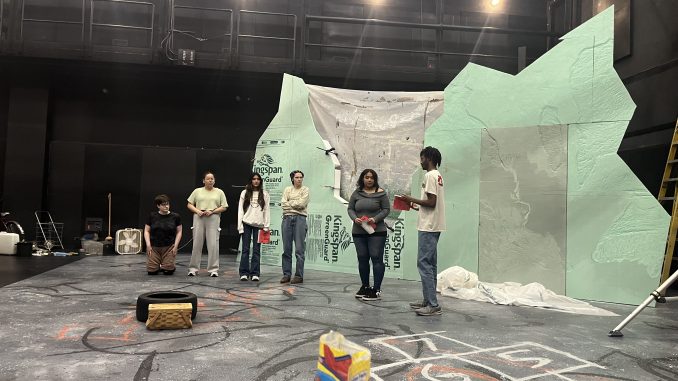
Content Warning: The following article concerns a play containing portrayals of verbal abuse, rape, and violence against minors. The Ursinus Theatre and Dance Department “very strongly discourage[s]” children from attending.
When a person is deprived of a voice by abuse and injustice, how can their story be told? The second show of the Ursinus Theatre and Dance Department’s 2025-26 season, Suzan-Lori Parks’ In The Blood, sheds a light on those that society prefers to leave in the dark.
An adaptation of The Scarlet Letter by Nathaniel Hawthorne, Parks’ Pulitzer-finalist play centers on Hester (Yadi Padilla ‘26), a homeless Black woman trying her best to provide for her five young children. Over the course of the show, the audience is introduced to a variety of characters — notably played by the same actors as the children — who hold power over Hester and use it to influence or harm her. According to Padilla, circumstances like Hester’s, though often not talked about, “[are] very, very common, so the play gives you a worldwide view of how situations like that can turn out… [if] you don’t have any support from family or friends.”
The difficult nature of the script, which involves a number of challenging scenes ranging from sexual content, to violence, to several different modes of abuse, requires the actors to intentionally support each other. Kat Carey ‘27 plays Reverend D., an abusive religious leader whom Carey describes as, “the bad guy. A guy who really does not have any redeeming qualities whatsoever,” as well as Hester’s two-year-old son, Baby. According to Carey, playing both a child and an abuser involves the unique challenge of transitioning quickly from an “irredeemable” character to an entirely innocent one. “It’s nice,” they say, “having the support of every single person around me while I’m trying to navigate those things. All the characters are really, really hard to play.”
In addition to the emotional challenges of the text itself, the actors involved in In the Blood find playing their characters in a respectful, grounded manner central to the message of the show. Padilla says of Hester: “I want to be able to play her honestly… [I am not] playing this homeless person just because I can. I want to actually portray her story and get people thinking as soon as they leave the theatre. I want to change people’s thoughts and be able to raise awareness for people like Hester.”
Carey also places great importance on the social commentary elements of their performance. They want to “have people’s eyes opened. This is reality, because there are different levels of privilege [in the world], and not every level of privilege is going to experience what Hester experiences,” and they feel that the show can help build empathy and understanding for oppressed people.
Mia Bompensa ‘28, plays Hester’s daughter, Bully, as well as her social worker, Welfare. Bompensa emphasizes that the show also shines in moments of levity, especially in scenes that involve Hester’s children: “We’re playing a family. There are scenes where it’s one-on-one and we’re doing some really tough material… but finding those glimmers of happiness and joy with each other really helps support everybody along the way.” She adds, “I hope people come to the show and are entertained, at the end of the day. I don’t want it to… [only] make you depressed… This is going to make you feel a certain way, but I hope we also entrance you and fascinate you and draw you in.”
In The Blood opens October 30th and closes November 2nd. Tickets and further details, including a summary and content advisory, are available on the Theatre and Dance department’s page of the Ursinus website.
